Let’s just call it what it is: most dental marketing is a complete waste of money.
You’ve probably tried the usual suspects:
Billboards.
Postcards.
Some half-baked SEO agency that promised “page one” but couldn’t coherently explain how Google even works.
Maybe you even dropped $10k on a fancy new website that looks great… but doesn’t show up anywhere that actually matters.
Here’s the cold, ugly truth: your patients aren’t looking at your billboard on the freeway. They’re Googling “dentist near me” on their phone while lying in bed with a throbbing molar.
And if you’re not one of the top 3 results in the map pack, you might as well not exist.
Sound harsh? Good. Because the only thing more painful than a toothache is watching great dentists get crushed by mediocre practices with better online visibility.
And no, this isn’t just about “getting found online.” This is about completely rethinking how dental practices attract new patients in 2025.
What used to work—generic SEO, boosted Facebook posts, whatever your cousin’s nephew said he could do for $300—is officially dead.
If you’re still playing the old marketing game, you’ve already lost.
The dentists winning today aren’t always the most experienced or most talented. They’re the ones who’ve figured out how to show up everywhere patients are searching, using local SEO for dentists.
On Google Maps.
On mobile devices.
In local directories.
And yes, even in paid ad slots when it makes sense.
This blog isn’t for the faint of heart. It’s for practice owners who are done with excuses and ready to actually grow.
If that’s you, buckle up. We’re about to break down the exact system that gets real dentists ranked in real cities, attracting real patients with real money.
Let’s go.
Table of Contents
What Local SEO For Dentists Means (And Why Most Dentists Are Getting It Wrong)
Local SEO isn’t just “doing SEO but locally.” It’s an entirely different animal. And most dentists—and the overpriced agencies they hire—are completely screwing it up.
If your SEO “strategy” consists of some thin blog posts, a few backlinks, and hoping your homepage shows up on Google someday… you’ve already lost.
Google doesn’t care about your pretty website if your Google Business Profile is a ghost town and your name, address, and phone number are inconsistent across the internet.
Here’s what actually matters now:
The 3 Pillars of Local SEO Success for Dental Practices:
1. Maps Pack Dominance (Google Business Profile)
This is the holy grail. When someone searches “dentist near me,” Google throws up a little box with 3 local practices. That box gets over 44% of total clicks, before anyone even looks at organic results or ads.
If you’re not in that top 3, you’re invisible.
2. Organic Local Rankings (Your Website’s Local Authority)
This is where your site shows up under the map pack. It still matters, but only if it’s optimized around your services, your area, and your patients’ intent. Not some generic “Welcome to our practice” fluff.
Google now ranks based on real user signals: location-specific keywords, high-quality service pages, mobile usability, page speed, schema markup, and content that actually answers real patient questions.
Translation: if your site loads slow, has one generic “Services” page, and doesn’t mention your city in context, you’re screwed.
3. Paid Placement (Because SEO Alone Isn’t Enough Anymore)
Let’s get brutally honest: organic visibility doesn’t always cut it, especially in competitive markets. The smart practices aren’t avoiding paid ads. They’re using them strategically to plug gaps and dominate high-intent keywords.
Running hyper-local Google Ads on mobile for “emergency dentist open now” isn’t wasting money. It’s printing new patient leads when done right.
And guess what? Google is slowly shrinking organic real estate.
First comes the sponsored results. Then the map pack. By the time someone scrolls down to find your organic listing, they’ve already booked an appointment with the top 3 results above you.
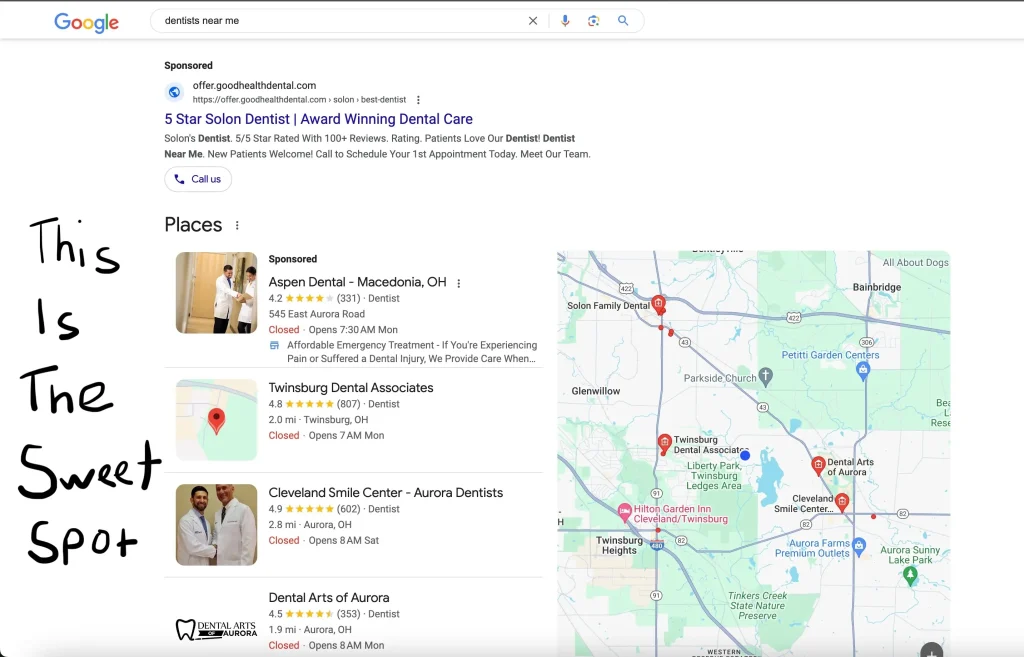
The Blended Strategy Is the Only Strategy That Works in 2025
You don’t get to pick one lane anymore. If you want to win, you need to show up everywhere your patients are looking:
- On Google Maps when someone’s in pain
- On organic results when they’re shopping around
- On paid ads when they’re ready to book
That’s not optional. That’s survival.
Recent stat: 98% of consumers used the internet to find information about local businesses in the last year, and over 87% of those searches start on Google.
So yeah local SEO isn’t a trend.
It’s not a “nice-to-have.”
It’s the lifeline of your entire marketing ecosystem.
Nail it, and you dominate your market.
Ignore it, and you’ll keep wondering why your ops schedule is half empty on Thursdays.
Your Google Business Profile Is the MVP of Your Marketing (And You’re Probably Ignoring It)
Look, I’m gonna say something that’s going to make a few marketers uncomfortable:
Your website is NOT the most important piece of your online presence.
You read that right.
The real MVP? Your Google Business Profile (GBP).
Not your blog.
Not your Instagram.
Not your “About Us” page with that awkward team photo from 2018.
If your GBP is half-baked, you’re leaving tens of thousands in revenue on the table every year.
And most practices? It’s a total disaster. I see it all the time.
Here’s what your patients actually see:
When someone searches “dentist near me,” they’re not reading your blog post about flossing techniques. They’re looking at:
- Your star rating
- Your review count
- Whether your photos look like a haunted DMV or an actual dental office
- Whether you’re even open
- And if you take their damn insurance
And they’re doing it all without ever clicking to your site. Think I’m being dramatic?
- 76% of people who search for something nearby on their phone visit a business within 24 hours.
- 28% of those searches result in a purchase.
So yeah, your Google Business Profile isn’t just a profile. It’s your new homepage.
What Most Dental GBPs Look Like (And Why That’s a Problem)
After analyzing hundreds and hundreds of dental practice GBP’s, here are the most common things I see:
- Missing categories
- No photos or 3 grainy ones from 2015
- No services listed
- Zero Q&A responses
- A copy-paste business description that says nothing useful
Let’s put it bluntly: it looks like you don’t care about your business. So why should a patient trust you with their teeth?
The GBP Optimization That Actually Moves the Needle
1. Categories That Actually Reflect What You Do
Your primary category should be “Dentist” or your specialty (Orthodontist, Endodontist, etc.), but don’t stop there.
Add relevant secondaries like:
- Cosmetic Dentist
- Emergency Dental Service
- Pediatric Dentist
- Teeth Whitening Service
- Dental Implants Periodontist
Use all 10 category slots if they apply. Each one expands the kinds of searches you can rank for in the map pack.
2. Business Description = 750 Characters of Ranking Fuel
Don’t waste this with “At Smile Dental, we believe in excellence and compassion.” Yawn.
Use geo-targeted keywords and services patients search for. Like this:
“Dr. Harris Dental is a family and cosmetic dentist in Scottsdale, AZ specializing in same-day crowns, Invisalign, and dental implants. We accept most PPO plans including Delta Dental and Aetna, and offer weekend appointments for busy professionals and families.”
3. Photos That Build Trust and Book Appointments
Stock photos scream “I’m faking it.” Real photos say, “Here’s exactly what to expect.”
Minimum:
- Exterior (with signage)
- Interior (clean, modern, inviting)
- Team headshots
- Operatories
- Before/after photos
- Real patients (with permission)
- Bonus: 30-second walkthrough video
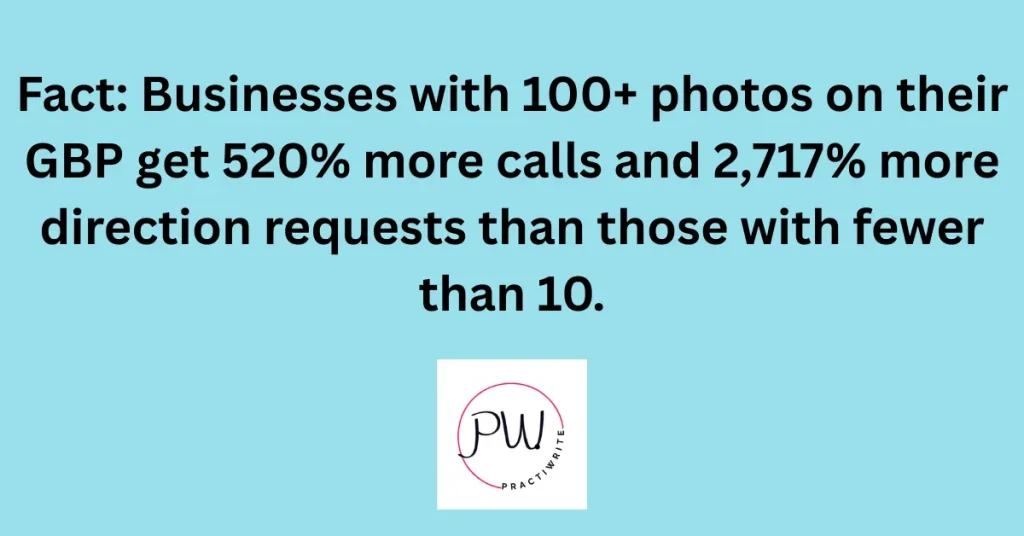
4. Services and Pricing: Be Transparent
List every service. Add simple explanations. Include price ranges when possible. Patients are searching things like:
- “How much is a crown near me?”
- “Is Invisalign covered by Delta Dental?”
- “Do you offer sedation for anxious patients?”
If your GBP answers those, you win.
5. Google Q&A: Your Secret Weapon
Yes, you can seed your own Q&A. Do it. Now.
Add 10–15 pre-written questions patients are already asking:
- “Do you see kids?”
- “Do you offer payment plans?”
- “Do you take United Healthcare dental insurance?”
- “What’s your cancellation policy?”
You’d be shocked how many practices leave questions unanswered for months. That’s like ignoring someone standing at your front desk.
If You Only Fix One Thing in Your Online Marketing, Fix This
Let’s recap. If your Google Business Profile:
- Isn’t fully built out
- Isn’t stuffed with geo-optimized, patient-focused info
- Isn’t loaded with real, compelling photos
- Isn’t updated weekly with posts and Q&A responses
…then you are literally handing patients to your competitors.
The best part? Most of this is completely free.
No ad spend.
No developer.
Just time, strategy, and a little effort.
Why You’re Not Showing Up in the Google Maps Pack (And How to Fix It Fast)
Let’s kill the myth right now: ranking in Google Maps is NOT random.
If you think the practices showing up in the top 3 for “dentist near me” are just “lucky,” I’ve got news for you.
They’re beating you on purpose.
They’re not better dentists.
They don’t have shinier offices.
Heck, they might not even have better reviews.
But they’re playing the Google Maps game strategically and you’re not even on the field.
Here’s Why You’re Invisible in the Maps Pack:
Why aren’t you showing up in the Maps Pack after all that work your agency did?:
1. Your Practice Isn’t Relevant to What They Searched (Because You Didn’t Optimize for It)
If someone searches “emergency dentist,” and your Google Business Profile doesn’t list “Emergency Dental Services” as a category or service, guess what?
You don’t exist in that search.
Google isn’t a mind reader. If you don’t tell it exactly what you do and where you do it, it won’t show you, even if you’re literally across the street.
2. Your Reviews Are Weak (Or Nonexistent)
Google uses reviews to determine prominence. It’s not just about quantity, it’s about quality, frequency, and keywords in those reviews.
Fact: Listings with 200+ reviews and a 4.7+ star average are dominating competitive markets. In some cases, they rank even when they’re farther away from the searcher.
If you’ve got 37 reviews from 3 years ago and your competitor has 278 fresh ones with the word “implants” sprinkled throughout (if they’re an implant provider), you lose.
3. You’re Getting Crushed by Proximity
Google heavily prioritizes location. If a patient is searching from 2 miles away and another dentist is 0.4 miles away with a halfway decent profile, they’re getting the click.
You can still outrank closer competitors if your relevance and prominence signals are stronger. That’s how one of our clients in a brutally competitive downtown market now outranks 10 closer offices. Because we beat them on every other signal.
4. Your Citation Profile Is a Hot Mess
Google checks your business info across the web to verify it’s legit. If your practice name, address, and phone number (NAP) are different on Yelp, Healthgrades, Yellow Pages, and 20 other sites?
Google doesn’t trust you. And if it doesn’t trust you, it doesn’t rank you.
Even something as “tiny” as using “St.” on one site and “Street” on another can jack things up.
The Big 3: What Google Cares About in Map Rankings
Let’s break it down in plain English. Google’s local algorithm is based on:
1. Proximity
How physically close your practice is to the person searching. You can’t control this—but you can outrank closer competitors if you’re better in the next two categories.
2. Relevance
Do your categories, services, business description, posts, and reviews line up with what people are searching for? If you’re not optimizing for “Invisalign,” “Dental Implants,” “Emergency Dentist,” or “Pediatric Dentist”, you won’t show up for those.
3. Prominence
How much authority Google thinks you have based on reviews, backlinks, citations, and brand mentions.
This one you can absolutely control and most dentists don’t.
Stat: Businesses that appear in the top 3 of Google Maps have an average of 47% more online citations than those in positions 4–10 (Moz, Local Search Ranking Factors).
Visual Breakdown: What It Takes to Rank in Google Maps
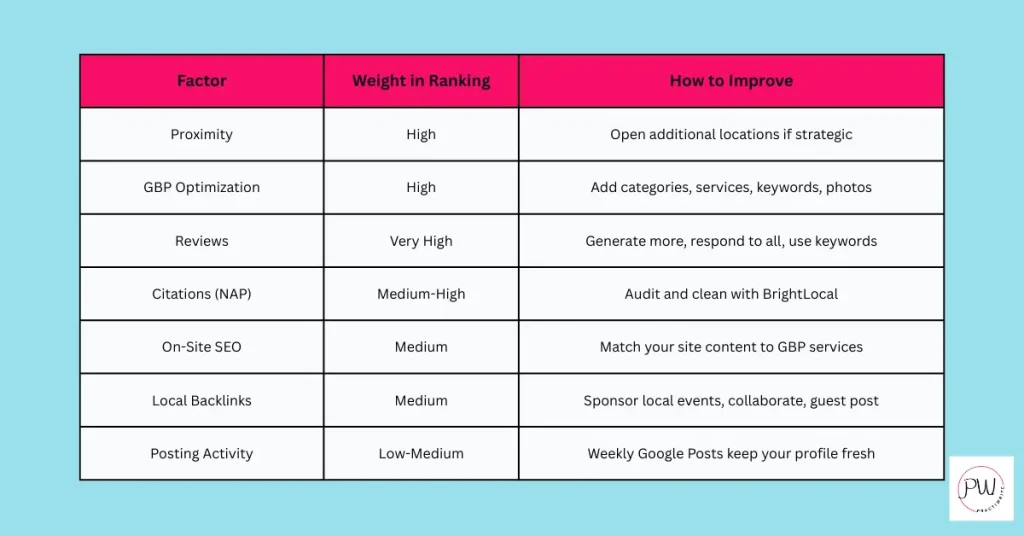
Want to Rank in Maps? Start Here:
- Fix your GBP (covered in Section 2)
- Audit your citations with tools like Whitespark or Moz Local
- Launch a review generation system (text every patient after every visit)
- Start using geo-modified keywords in posts and responses (“Dr. Lee is the best implant dentist in Dallas!”)
- Get backlinks from local sources—even small blogs or news sites matter
The bottom line? Ranking in Maps is the fastest, most cost-effective way to flood your practice with new patients.
But it’s not something you “set and forget.” It’s a system. And the dentists who follow it are dominating their cities.
Your Website Isn’t Just a Brochure (It’s a Conversion Machine If You Build It Right)
Let’s not sugarcoat this: Most dental websites are useless.
They look like they were built in the 90’s. They’ve got stock photos of weirdly perfect smiles, cookie-cutter service pages, and zero real strategy.
And worst of all?
They don’t convert.
If you’re not getting regular appointment requests through your site, your “modern design” doesn’t mean squat.
The truth is, a beautiful website that doesn’t rank or convert is just a digital business card nobody asked for.
And don’t tell me your nephew “built it for you on Squarespace.” That’s like saying your cousin’s band will play your wedding because they have a guitar.
The Dental Website Litmus Test
Pull up your website right now on your phone (not your desktop, because 70% of dental searches happen on mobile). Can you…
- Tap-to-call with one click?
- Find your address and get instant directions?
- Book an appointment without digging around?
- Tell what services you offer in 5 seconds or less?
If the answer is no, then your website is bleeding money.
The 3 Jobs Your Website Must Do (And Nothing Else Matters)
1. Rank Locally
If you’re not showing up when someone searches “dentist near me” or “dental implants [your city],” your website might as well not exist (this is also a component of GEO, which you also need to optimize for).
Fact: Google now uses mobile-first indexing. That means it ranks your site based on how your mobile version performs—not your desktop (Google Search Central).
2. Convert Visitors Into Patients
Your site needs to grab attention, build trust in seconds, and make it stupid-easy to book.
Think clear headlines, real patient photos, benefit-driven service pages, and bold calls-to-action that actually say something.
BAD: “Contact us.”
GOOD: “Schedule your free implant consult today—plus get $500 off if booked this month.”
3. Reinforce Trust
Most patients are skeptical. They’ve been ghosted by dentists, burned by bills, or just don’t trust healthcare in general. Your website has to overcome all that by showcasing:
- 5-star reviews
- Real team photos
- Actual case studies or before/after shots
- Insurance info and financing options
- FAQ answers to real questions
Why Most Dental Sites Fail (And Yours Might Too)
Let’s hit some hard truths:
- Your site speed sucks. If it takes more than 3 seconds to load, you’re losing 53% of visitors before they even see your homepage.
- You have one generic Services page. Google doesn’t rank general “we do teeth stuff” pages. It ranks specific, detailed pages for specific services like “Invisalign in San Diego.”
- Your navigation is confusing AF. Too many dropdowns, too much clutter. If patients can’t find what they need in one click, they’re bouncing.
- Your content is written for other dentists. Stop talking about your technology. Patients don’t care about your CAD/CAM system. They want to know:
- Will it hurt?
- Will insurance cover it?
- How much will I pay out-of-pocket?
- Will it hurt?
What a Patient-Generating Website Actually Looks Like
Let me break it down for you.
Website Architecture Blueprint:
css
CopyEdit
Homepage
├── About
│ ├── Meet the Dentist
│ ├── Our Team
│ └── Office Tour
├── Services
│ ├── General Dentistry
│ │ ├── Cleanings & Exams
│ │ ├── Fillings
│ │ └── Root Canals
│ ├── Cosmetic Dentistry
│ │ ├── Teeth Whitening
│ │ ├── Veneers
│ │ └── Invisalign
│ └── Restorative Dentistry
│ ├── Crowns
│ ├── Bridges
│ └── Dental Implants
├── Insurance & Financing
├── Location Pages
│ ├── [City 1 Office]
│ └── [City 2 Office]
└── Contact / Appointment Booking
Every major service gets its own page. Each location gets its own page. Every single one is optimized for keywords + local relevance.
Each Service Page Must Include:
- Keyword-rich headline
- Real patient benefits (not features)
- Step-by-step overview of what to expect
- Cost, insurance, and payment info
- Before/after photos (with permission)
- FAQs that reflect real Google queries
- Strong CTA (“Book now,” not “Learn more”)
Pro Tip: Use Real Patient Language (Not Dentist-Speak)
You’re not writing a CE course. You’re writing for someone Googling answers at 11:30pm with a cracked molar and a $1,500 deductible.
Use phrases like:
- “Pain-free root canal in under 90 minutes”
- “Get your smile back with permanent implants”
- “Same-day crowns with no goopy impressions”
Speak like a human. Sell like a pro.
The 5-Second Website Test (Pass or Perish)
Within 5 seconds, a first-time visitor should know:
- What you do (We’re a dentist)
- Where you do it (In [City])
- What makes you different (We offer [XYZ services] with [unique value])
- Why they should trust you (5-star reviews, credentials, patient proof)
- What to do next (Call or book online)
Can your site pass that test? If not, it’s time to fix it.
TL;DR: You Don’t Need a Prettier Website. You Need a Smarter One.
Forget the aesthetics. Forget the fluff. Build a website that ranks, converts, and actually makes you money.
Content Strategy for the 2025 Patient (No More Fluff, Only Fire)
Let me say this as clearly as possible: Most dental content sucks.
You know the type:
“5 Tips for a Healthy Smile!”
“The History of Toothpaste!”
Or the all-time snoozer: “Why Flossing Is Important.”
No one’s reading that.
Not your patients.
Not Google.
Not even your hygienist who pretends to skim your blog during lunch.
You don’t need content for content’s sake. You need content that shows up in search, builds trust, and books patients.
And to do that, you need to understand how the modern dental patient actually behaves online.
Today’s Patient Journey Starts with One Thing: A Google Search
They don’t ask their neighbor. They don’t check the Yellow Pages. They pick up their phone and type:
- “Dentist open Saturday near me”
- “Does Delta Dental cover implants?”
- “Emergency tooth extraction no insurance”
- “How much does Invisalign cost in Austin?”
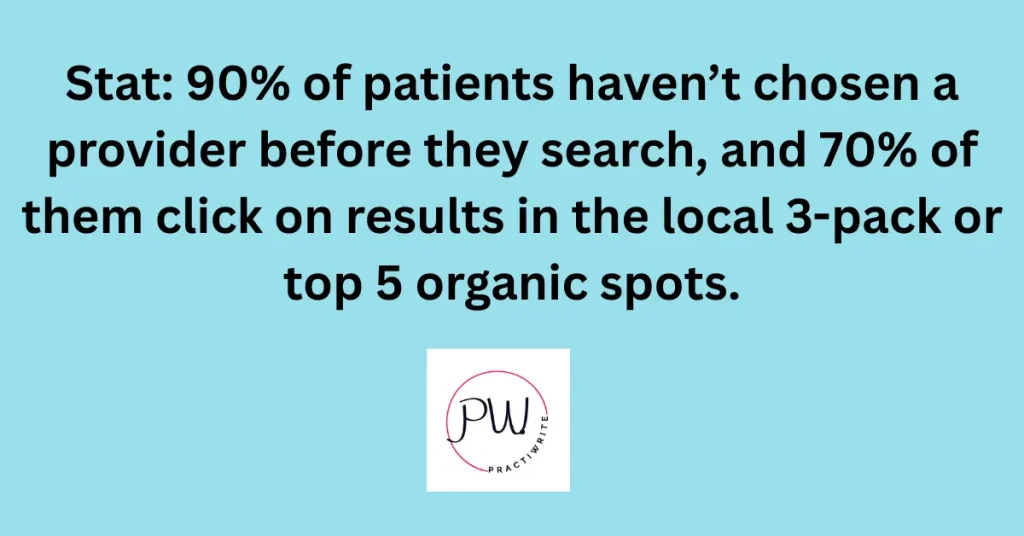
Your content either answers those questions, or Google shows someone else who does.
The 3 Types of Content That Actually Bring in New Patients
1. Service Pages That Convert and Rank
Each service you offer needs its own dedicated, optimized page. No “We do everything!” general pages. Google hates that. So do patients.
Here’s what every high-performing service page needs:
- Location-optimized headline:
“Dental Implants in Miami | Permanent, Natural-Looking Tooth Replacement” - Real benefits, not features:
BAD: “We use titanium implants and 3D scanning…”
GOOD: “Smile, eat, and speak confidently again with implants that last a lifetime.” - Cost and insurance info:
If you avoid it, patients will bounce to someone who doesn’t. - Before/after photos & testimonials:
These close more deals than your “Meet the Doctor” video ever will. - Specific, keyword-rich FAQs:
- “Does dental insurance cover implants?”
- “How long does a crown last?”
- “Are veneers permanent?”
- “Does dental insurance cover implants?”
Pro tip: Use AnswerThePublic to find the exact questions your patients are Googling—and answer them on the page.
2. Location Pages That Don’t Suck
If you have more than one office—or want to dominate nearby towns—you need location-specific content that’s not just a copy-paste job with a new city name.
Each location page should include:
- Services offered at that location
- Specific directions and parking tips
- Photos of that office + team
- Location-based testimonials
- Local flavor (e.g. “Serving families near the Westfield Mall in Citrus Heights”)
Bad location page: “Welcome to our dental office in [City Name]! We offer great care in a comfortable setting.”
Good location page: “Located just 5 minutes from downtown Raleigh, our Glenwood office offers same-day crowns, free validated parking, and early morning appointments for busy professionals.”
3. Blog Content That Answers Real Patient Questions
If your blog is just sitting there with “National Gum Health Month” posts, kill it. With fire. Right now.
Here’s what to post instead:
Local Keyword-Driven Topics:
- “How Much Do Veneers Cost in Phoenix (And Are They Worth It?)”
- “Emergency Dentist in Houston: Where to Go When It’s 10pm and You’re in Pain”
- “Invisalign vs. Braces in Dallas: What Real Patients Need to Know”
Hyper-Local Content:
- “Top 5 Family Dentists Near Lincoln Park (Ranked by Google Reviews)”
- “Dr. Patel’s Picks: 7 Smile-Friendly Restaurants in San Diego”
- “Where to Get Free Dental Care During National Children’s Dental Health Month in Tampa”
Comparison + Decision-Making Guides:
- “Dental Implants vs. Bridges vs. Dentures—Which One Is Right for You?”
- “Are Mail-Order Aligners Safe? What Dentists in Chicago Are Saying”
- “Is Sedation Dentistry Worth It? Pros, Costs, and What to Expect”
Pain Point Blog Posts:
- “Why Your Dental Insurance Doesn’t Cover Implants (And What You Can Do)”
- “Afraid of the Dentist? Here’s What We Do Differently for Anxious Patients”
Want Google to Rank You? Write Like a Human, Not a Robot
Keyword stuffing is dead. Google can read natural language now (thanks, AI). That means your content should sound like a real human talking to another real human. Not like a clunky robot reciting “dental implant Phoenix dentist best top.”
Talk like your patients think. Use contractions. Use slang if it fits.
Be direct, real, and helpful. That’s what wins.
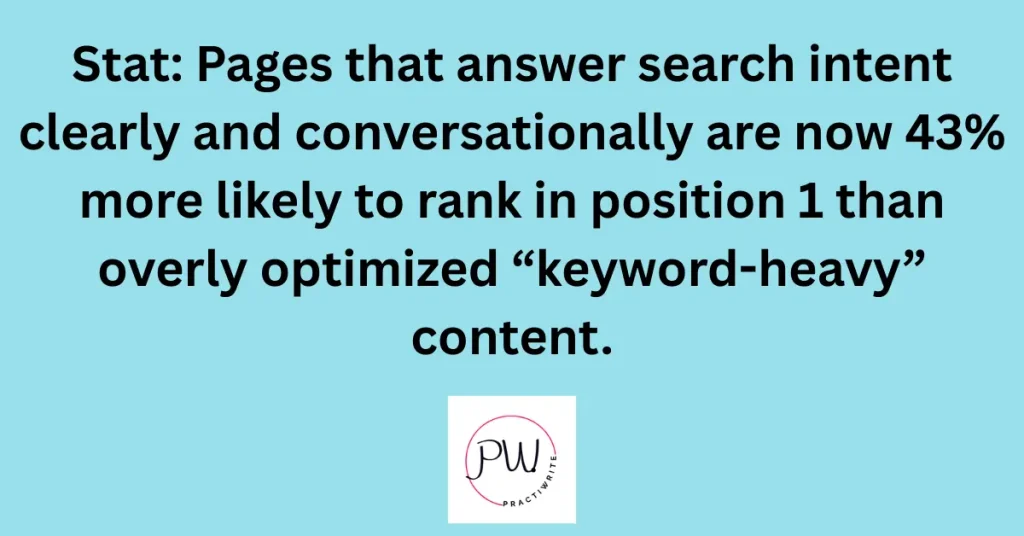
Content That Ranks + Converts = These 3 Things:
- Matches search intent (what the patient actually wants to know)
- Demonstrates expertise and empathy
- Includes a clear, specific call to action
No more “Click here to learn more.”
Use: “Schedule your free Invisalign consult—plus get $250 off if booked this week.”
The Power of Reviews and Social Proof (You’re Either Winning with Them or Losing Because of Them)
Patients don’t trust you (I know I said that already but it bears repeating). Not yet.
And they sure as heck don’t care about your CEREC machine or how long you’ve been practicing unless other people—real people—are vouching for you.
That’s why reviews aren’t optional. They’re the most important trust signal in your entire marketing strategy.
Stat: 84% of people trust online reviews as much as a personal recommendation, and 93% say reviews influence their buying decisions, especially in healthcare.
You want to know who’s showing up in the Google Maps 3-pack:
The dentist with the most reviews.
The best reviews.
The most recent reviews.
Every single time.
Let’s Get Brutal: If You Have Less Than 100 Google Reviews, You’re Losing Patients Every Day
You can be the best clinician in your city, but if your competitor has:
- 287 five-star reviews
- A 4.9 average
- Fresh reviews every week
…and you have:
- 48 reviews
- A 4.2 rating
- Nothing new in six months
You’re not even in the conversation.
Because here’s how patients scroll:
They look at your stars, your count, and your most recent 3 reviews. If they don’t see words like “gentle,” “painless,” or “explained everything”—they’re gone.
Review Math: Why Quality + Quantity + Recency = Cash Flow
Let’s break it down.
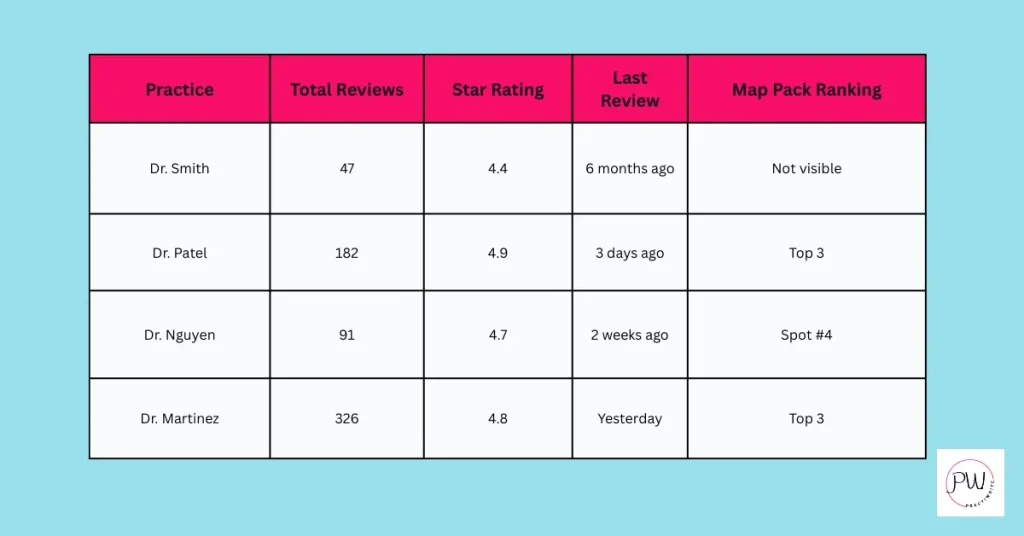
The Takeaway: If you’re not actively generating reviews and responding to them, you are absolutely getting outpaced by practices that are.
What Google Wants to See in Your Review Game
1. Volume
Shoot for 200+ reviews minimum. The top 3 ranking dental practices in most U.S. metros? They average 250–350 Google reviews.
2. Frequency
Google wants freshness. A review from yesterday > 10 reviews from 2 years ago.
3. Keywords in Reviews
Google reads the content. If your patients are using phrases like “Invisalign,” “gentle cleaning,” or “emergency visit,” that boosts relevance.
4. High Star Rating
You want 4.7 stars or higher. Below that? People start thinking “ehhh…”
How to Generate Reviews on Autopilot (No, You Shouldn’t Be Emailing Patients One-by-One)
Here’s the system:
- Ask every single patient right after their visit. Not next week. Immediately.
- Use SMS, not email. Text gets read. Email gets ignored.
- Use a platform like:
- Birdeye
- Podium
- Swell
- Or even Google’s free review link generator
- Birdeye
- Train your team to ask. Not “Would you mind leaving us a review?”
Use: “Hey, you’ve been awesome today—can I text you a link real quick to leave us a Google review? It seriously helps more than you know.” - Make it stupid-easy. One link. One tap. Boom.
How to Respond to Reviews Like a Pro (Not a Robot)
Positive Reviews? Don’t just say “Thanks.”
Add personality + keywords:
“Thank you, Mary! We’re so glad you loved your teeth whitening results. Enjoy showing off that smile at your reunion!”
Negative Reviews? Don’t get defensive.
Be calm. Be empathetic. And move it offline.
“Hi James—thank you for your feedback. We take this seriously and would love to speak with you directly to make things right. Please call our office at your convenience.”
The response isn’t just for that patient. It’s for every future patient reading it.
The Bottom Line: Reviews Are the Shortcut to Trust
- Reviews influence both your rankings AND your conversions
- Patients will book with a slightly more expensive dentist if that dentist has a higher rating and more credibility
- You control your review velocity, quality, and response rate—so stop pretending it’s “organic”
Stat: Listings with 200+ reviews and a rating of 4.8 or higher receive up to 5X more calls and direction requests than those with fewer than 50 reviews.
Paid Search as a Strategic Supplement (Not a Money Pit—If You Do It Right)
Let me guess…
You tried Google Ads once.
Spent a few grand.
Got a bunch of clicks from out-of-network Medicaid patients looking for $20 cleanings. And decided “Google Ads don’t work for dentists.”
Wrong.
Your strategy sucked.
Google Ads absolutely work—for the practices that know how to use them like a scalpel, not a shotgun.
The truth is that SEO alone won’t cover all your search visibility anymore.
Google keeps cramming more paid placements into the results. Organic real estate is shrinking because of AIO. Ads are no longer optional. They’re part of the blended strategy that gets you found fast and fills gaps SEO can’t cover.
SEO + PPC = Total Search Domination
Let’s say a potential patient searches “emergency dentist near me.”
What they’ll see:
- 2–4 sponsored ads at the top
- The Google Maps 3-pack
- Organic listings
If you’re running ads AND ranking in the map pack AND showing up in organic, you’re everywhere.
It’s not about choosing one channel.
It’s about owning the whole damn screen.
When to Use Paid Search (And When to Chill)
✅ Use Ads To:
- Launch or relaunch a location
- Promote high-margin services (e.g., implants, Invisalign, sedation)
- Target emergency intent (“tooth extraction near me open now”)
- Cover ranking gaps in nearby cities you haven’t broken into yet
- Show up in competitor searches (“Intercept” traffic from practices patients are Googling)
❌ Don’t Use Ads To:
- Drive traffic to a weak, slow, non-converting site
- Promote low-intent search terms (“dentist info”)
- Bid on broad terms with no geo modifiers
- “Just try it for a month” with no strategy
If you don’t know your numbers—cost per click, conversion rate, cost per new patient—you’re not doing marketing, you’re gambling.
Here’s How Dentists Waste Thousands on Ads (And How to Stop)
1. You’re Using Google Smart Campaigns (aka: Google’s Way to Drain Your Wallet)
These “automated” campaigns suck. They give you zero control over targeting, bidding, or keywords. You’re trusting Google to spend your money for you. Don’t.
2. You’re Not Using Landing Pages
Sending traffic to your homepage is like dumping people into a maze with no exit.
You need service-specific, high-converting landing pages that match the ad 1:1.
Example:
Ad: “Dental Implants in Denver – Free Consultation + $500 Off”
Landing Page: Only about dental implants. No nav menu. Just reviews, cost info, and a bold booking form.
3. You’re Not Tracking Conversions
If you don’t know which keywords drive actual calls and bookings, how do you optimize?
Set up call tracking.
Use CallRail.
Tag every form.
Track every source.
The Smart Dentist’s Paid Strategy: The Search Funnel
Visual: Dental Search Funnel
less
CopyEdit
Top: Awareness (Display Ads, Facebook Ads)
Middle: Consideration (Google Search Ads, Maps visibility)
Bottom: Decision (Retargeting Ads, Emergency Ads)
PPC doesn’t replace SEO. It amplifies it. When used right, it fills the cracks, boosts branded searches, and captures urgent buyers when SEO hasn’t caught up yet.
How Much Should You Spend?
- $1,500–$3,000/month for most practices in competitive metros
- Focus on bottom-funnel, high-converting keywords
- Track your cost per acquisition (CPA). A healthy target:
- General dentistry: $75–$150 per new patient
- Specialty services: $150–$300 per new patient
- General dentistry: $75–$150 per new patient
If your ads are costing you $500+ per patient… something is broken. Fix the targeting, the landing page, or the follow-up.
Tools to Help You Win at PPC (Without Getting Burned)
- Google Ads Keyword Planner
- Unbounce or Instapage for landing pages
- CallRail for call tracking
- WhatConverts for advanced attribution
Or… just hire someone who knows dental PPC cold.
Not a generalist.
Not your brother-in-law (no offense to him).
Not the guy who does “SEO and social.”
Ads Won’t Save You—But They’ll Supercharge What’s Already Working
If your site sucks, your GBP is neglected, and you’ve got 27 Google reviews from 2019, ads won’t fix that.
But if your foundation is solid ads pour gas on the fire.
Used right, they get you more of the patients you want, faster. Used wrong, they light your marketing budget on fire.
Your move.
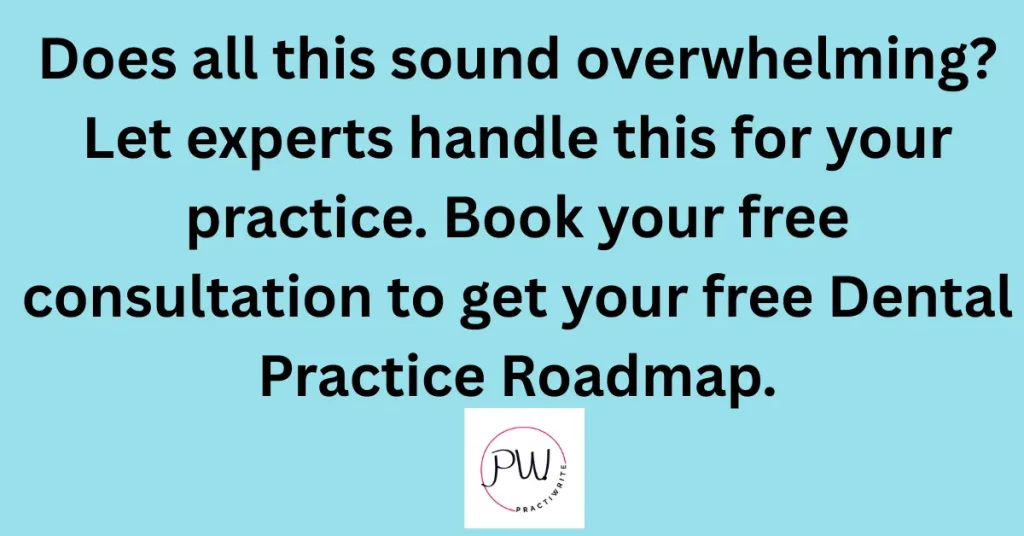
Final Words: Take Control or Stay Invisible—The Choice Is Yours
Look, you didn’t pour blood, sweat, and six figures into dental school just to get outranked by a DSO with cookie-cutter branding and a call center.
You didn’t build a practice to be the “best-kept secret” in town.
You built it to serve, succeed, and scale.
But here’s the hard truth: None of that happens if patients can’t find you.
And right now, most of them can’t.
They’re out there, searching for what you offer. Implants, Invisalign, same-day crowns, emergency appointments, pediatric cleanings and you’re not showing up.
Because you’re still stuck in 2015 marketing while your competitors are playing 2025 chess.
So ask yourself:
- Are you sick of being invisible online while practices half your size eat your lunch?
- Are you tired of throwing money at random “marketing” and praying something sticks?
- Are you done being “pretty good” in a game that rewards digital dominance?
Then it’s time to stop guessing and start executing a real strategy.
Here’s Your Next Move: Book Your Free Dental Practice Roadmap
This isn’t a sales pitch.
It’s a no-BS, custom strategy session where we’ll show you:
- Exactly where your practice is falling flat online
- Why competitors are outranking and out-booking you
- What it’ll take to dominate your local market in the next 90 days
- A step-by-step Roadmap to ranking in the Google Map Pack, converting more site visitors, and turning reviews into revenue
No fluff.
No contracts.
No pressure.
Just clarity.
If you’re serious about growth, you can’t afford to ignore this.
If you’re not, well… enjoy watching your competition book the patients who should’ve been yours.
👉 Click here to book your free Dental Practice Roadmap now.
Let’s get you seen.
Let’s get you booked.
Let’s get you growing.
Because in 2025, dentists don’t just compete on clinical skill. They compete on visibility.
And if you’re not visible—you’re not even in the game.
Let’s fix that.
10+ year content strategist, writer, author, and SEO consultant. I work exclusively with dental practices that want to grow and dominate their local areas.
